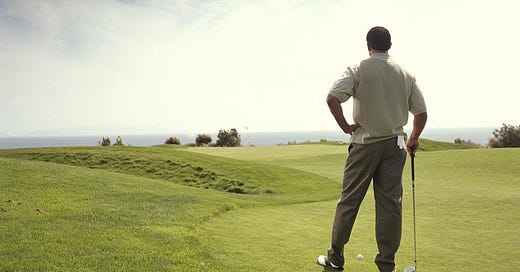With the prevalence of range finders and GPS, it is relatively easy to determine the "actual yardage" to the green. However, the "actual yardage" is often different than the "effective yardage". The "effective yardage" is the yardage that takes into account the four factors outside of the golfer's control that make a difference in how far a given club will send the ball.
1. Wind
You'll play very few rounds of golf when the wind doesn't come into play. When it does, the golfer needs to become part scientist and understand how the wind affects ball flight.
Golf balls are manufactured with dimples so the air moving across the ball will give it lift. The faster the air moves the faster and higher the ball will rise. If we assume that a golf ball comes off our club at 100 mph and we are hitting into a 15 mph breeze, the speed of the air across the dimples will be 115 mph resulting in the ball flight being higher.
That oncoming 15 mph breeze diminishes distance in two ways. First it will make the ball rise faster and higher, directing some of your ball's flight more upward than forward. Second, since the oncoming breeze is pushing against the ball, it creates resistance to the ball moving forward.
Conversely, when playing a hole in the opposite direction that same 15 mph breeze is not blowing against us but is coming from behind. Then our 100 mph ball speed is experiencing only 85 mph of lift. So although the wind is pushing our ball forward, it will not travel as high and thereby reduce carry. Crosswinds also reduce carry.
2. Elevation
Most players find golf on a flat course to be less interesting and less challenging. Therefore it is common that golf course architects will take advantage of an opportunity to position a green on a hilltop or in a valley. When they do the "effective yardage" is changed.
Here is one way that elevation impacts yardage. When we are standing on level ground, our pitching wedge sends the ball forward with a 46+ degree launch angle. Therefore a full wedge sends a little more than half your energy upwards. If we are standing on a 15-degree hillside our launch angle becomes 61+ degrees. Now slightly more than half of our energy is upwards. Hitting up this hillside, a club will carry a shorter distance and have less roll. Take more club. Playing downhill the wedge's loft becomes 31 degrees. It now has greater carry and a lot more roll. Take less club. The actual distance may be 100 yards but uphill or downhill makes the "effective yardage" different.
Here is a second way elevation changes the "effective yardage". Again assume we are using our 46-degree pitching wedge and hitting to a green up a 30-foot hillside 100 yards away. A rule of thumb is to add one club for every 30 feet of elevation. The reverse holds true for hitting from a plateau to a green 30 feet below. It’s not uncommon for both these factors to come into play. Just image that you are at the base of that 30-foot hillside and your ball is sitting on the hillside itself. The "effective yardage" just got a lot longer.
3. Lie
The turf conditions can make a difference in the "effective yardage". When the ball is sitting down in longer turf two conditions to watch for: 1) a cushion of grass coming between the club face and the ball adequate to prevent the club from imparting its normal amount of backspin on the ball. On a chip shot this ball will travel slightly lower and roll more. On a fuller swing this lie can produce what is called a "flyer" which will travel further than expected, 2) when the turf gets long it can slow the club head as it descends through the grass to reach the ball. [This shot will not carry the normal distance]. In each case, the actual yardage is not the same as the effective yardage.
4. Temperature
At impact, the golf ball flattens out against the club face. The ball's response is to restore its shape. When it does, it effectively pushes off the club face and launches itself forward.
When a ball's temperature gets below forty degrees its compresses less and restores itself more slowly--it pushes away from the club more slowly. So when it gets below forty, expect the ball's carry to be shorter. As a rule of thumb, you can expect about a 5% drop in distance at that temperature. The colder it gets the bigger the drop.
Bottom Line: When you are playing, remember that "actual yardage" is only the starting point. We now want to consider the wind, elevation, lie, and temperature to allow us to figure the "effective yardage".
Each Thursday we’ll bring you a helpful insight.
Swing to the Target,
Ed
Learn from our Tube Videos
Have golf buddies? Share this article.





